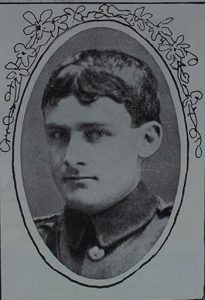Reading a Window
An artwork can carry more than one story. What it depicts is one thing, but the intention of the donor and the circumstances of it being erected are entirely another. Since the donor gets quite a say in the image chosen the two stories are frequently strongly linked. There is a very good example of this among the stained glass windows of St Mary’s Nelson.
The window depicts St Monica, the mother of the famous bishop of Hippo, St Augustine. Augustine describes himself as having had a rowdy youth and being heavily involved with a belief system called Manichaeism, to the intense disapproval of his Catholic mother. She was so upset by this that, when he returned to his home town of Tagaste in North Africa after his studies in Rome, she refused at first to allow him to live at home. She also poured out her sorrows and concerns to the local bishop. Augustine records the end of the encounter like this:
“The Bishop, a little vexed at her importunity, exclaimed, “Go your way, and God bless you, for it is not possible that the son of these tears should perish.” Which answer (as she often mentioned in her conversations with me) she accepted as though it were a voice from heaven.”Confessions 3,12,21
That the window aims to evoke this moment and Monica’s prayers for her son is made abundantly clear by the banderol held by the saint which reads “Go in peace. The son of so many tears will not perish.”
The window does not have a dedication beneath it, but the Colonist of 19 March 1919 records that it was erected as a memorial of a deceased parishioner Lieutenant Alan Shain. It was his mother, Julia Shain who was the donor and we may reasonably infer that she had shed many tears for her son and saw in the words spoken to Monica a message of consolation for herself.
Henry Alan Shain was born in Greymouth, 20 December 1892, the son of William and Julia Shain. At some stage they moved to Nelson and he attended Nelson College. They lived on a property called Blair Athol at Wakapuaka. He was a dental mechanic when he signed up for the Canterbury Mounted Rifles. He was 22 years of age when he was killed at Gallipoli – one hundred years ago on 6 August 1915. Here is an extract from the Nelson Evening Mail’s report of the sermon preached in St Mary’s by Rev. F. S. Bartley, S.M.
“It is not my purpose to-night to pronounce a panegyric on Lieut. Alan Shain. I wish to emphasise the right that he and his comrades have to our prayers. Ours not to conjecture the measure of their need, ours only to admit the fulness of their rightful claim. But this I do know that such a memory as that of Alan Shain, must be for us a priceless possession. I learnt from those who know him personally, and whose opinion I value, that he was everything an exemplary young Catholic should be, and perfect praise is praise sufficient. But I have spoken and corresponded with some who knew him at Anzac, one of them was with him on Sari Bair the night he met his death, and as soldier and officer he was respected, trusted and loved.
Amongst the finest exploits of military history must rank forever the taking of Sari Bair by the New Zealanders on August 6th of last year. Those raw recruits proved themselves seasoned veterans, disciplined and efficient, that night, as with whispered orders and stealthy advance they won two and a half miles depth of Turkish trenches. Quite different was the taking of Table Top by General Russell and his New Zealanders. All the drill books say such a slope is ‘impracticable for infantry,’ but drill books counted not on the fighting stuff of the men of Anzac. With the wild joy of a football forward rush, our bonnie lads won that impossible hill, but if on Table Top there was the brilliant elan of a Balaclava, there was on Sari Bair the grit and determination of a Thermopylae. The New Zealand Mounted Brigade was told to clear the Turkish outpost, the taking of which led up to the big attack on Sari Bair, and Alan Shain was sent out with a signalling party from the Canterbury Mounted Rifles. He went out at 9.30 p.m., and it was about midnight when he was hit, and died as he was being carried in; God rest his gallant soul! That very evening, about two hours before the attack, with another Nelson Catholic, he sought out Father Dore and made his confession and received holy absolution. Thus, with a soul, ‘shriven, housel’d, and annell’d,’ he went out that night: fit and ready to play his man’s part.”
So, the window tells two stories both about a mother and a son; one famous tale from the fourth century and a less well-known tragedy of last century.



 Entries(RSS)
Entries(RSS)